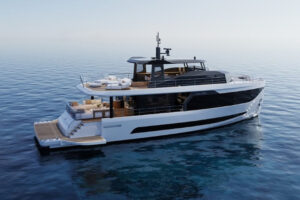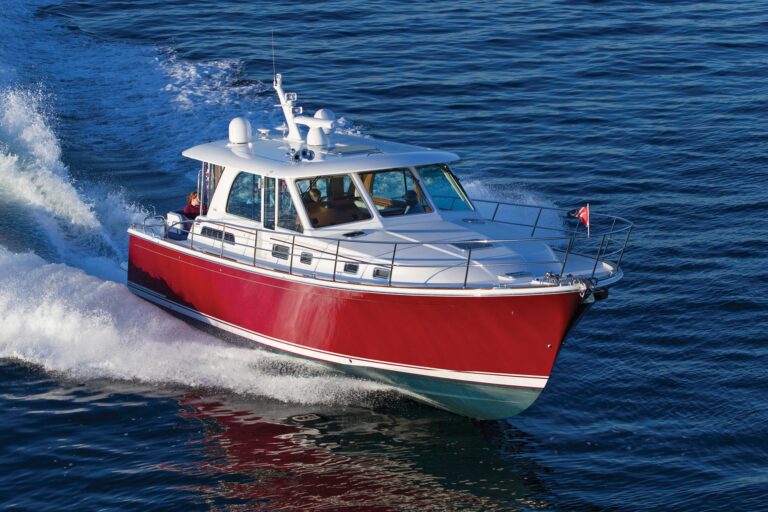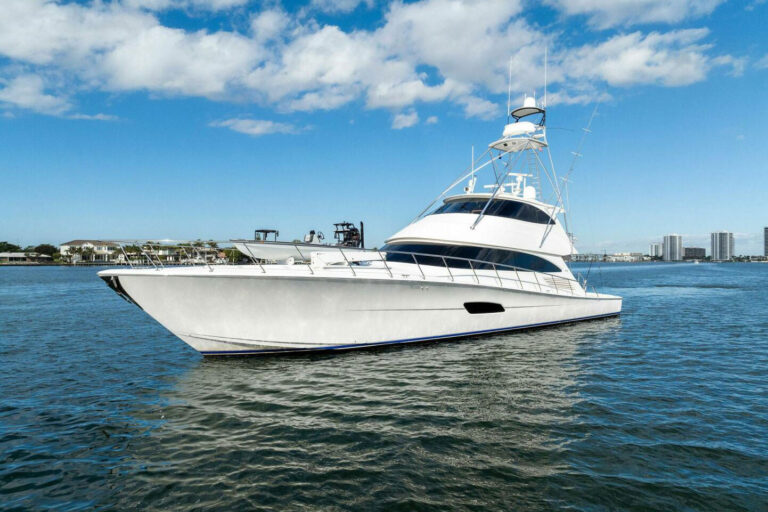Summer in Sardinia is a magical time. The storied island off the western coast of Italy comes alive as Europe’s rich and royal move into Porto Cervo and other venues along the Costa Smerelda. It is said the region is the way God would have made the rest of Earth if he could have afforded it.
After the hop from Rome to Olbia aboard Meridiana Air, it was just a short ride to Yacht Club Porto Rotondo, host of this past June’s inaugural Perini Navi Cup. The windswept shapes of the scrub trees along the craggy hillsides revealed a meteorological history that was to be retold in the mistral winds of the coming days.
Santa Maria, the newest of the 16 Perini Navi sailing yachts on hand for the regatta, strained at her multitude of mooring lines. At times, the mass of the 183-foot yacht’s deep-blue hull and the windage of her towering rig completely submerged the huge buoy to which her bow was tied, in the process rolling Burrasca, her sistership docked alongside. Santa Maria’s mainmast reaches 192 feet above the waterline, the mizzen to 158 feet.
Santa Maria and Burrasca are the first two yachts of a new 56-meter series from the Viareggio builder. Together they afforded an unprecedented opportunity to compare the construction, arrangement, outfit and performance of these magnificent creations both at the dock and under way.
As interested as I was, the yard’s staff was even more so, this being their first chance in 20 years for such a head-to-head competition among a large fleet entirely of their creation. The broad appeal of Perini Navi yachts is evident in the regatta’s ownership statistics, with four Americans, three Italians, and at least one owner each from Spain, Russia, Austria, France, Portugal and Greece. The yachting public, it seemed, was enthusiastic as well, with the spectator fleet including such significant motoryachts as Perfect Prescription, Golden Odyssey, Senses, Leander, and for a time, even the legendary Carinthia.
Constructed of aluminum, Santa Maria’s sleek hull is a result of Perini Navi’s collaboration with naval architect Ron Holland. Ron is a dedicated and knowledgeable designer and it was obvious he was thrilled to be aboard as the impressive fleet put to sea. Starting last in a handicapped staggered start, Santa Maria and Burrasca headed north from Porto Rotondo into the wind, quickly gaining on the smaller early starters, passing many of them by the midpoint at Monaci Rock before turning south again to run with the wind.
The sisters made a valiant effort, straining rigging, lines and sails, submerging sheer rails, and lifting rudders clear of the water, but overall victory was not to be theirs. There was, of course, speculation that the fault lay not with the big yachts or their eager crews, but with the handicapping formula. Regardless, a wonderful evening, capped by a fantastic fireworks display, was spent at Hotel Cala di Volpe to celebrate the successful completion of the race and to congratulate the winners.
Graciously taking a break from race preparations, Captain Fred Richter had shown me through Santa Maria the day before. He commands the yacht from port and starboard helms on the flying bridge, and for motoring, there’s a single wheel to starboard forward in the deckhouse, opposite the navigation station. It was here Richter shared the details of a new maritime radar system, similar to that of air traffic controllers, that tags each vessel’s blip with her name. In use for safety and security reasons aboard commercial ships, it is now undergoing trials on yachts in the 500-ton range.
Santa Maria sports a traditional interior dominated by light, matt-finished cherry. Satin panels in a medium shade of blue soften the bulkheads in some areas, and in the saloon, six paintings by artist Souza Pinto (1856 – 1936) adorn the space. Forward of the saloon, a formal dining room to starboard and a den to port afford the utmost in privacy and comfort for the owner and his family. The forward portion of the open aft deck is recessed a few steps, creating a cockpit to shield the complement from prying eyes when moored stern-to in the Med.
When Med moored, boarding is via a passerelle, which extends from the center of Santa Maria’s reverse transom. At anchor, the portside steps from the afterdeck to the cockpit swing up and out of the way, providing direct access down to a side platform which folds out of the yacht’s hull for boarding or swimming. When stowed, the underside of the platform blends so seamlessly with the hull that it is nearly impossible to see.
Santa Maria’s flying bridge extends further aft than does Burrasca’s, providing full shade over the aft cockpit and a larger area topside for the whirlpool spa and sunpads. The bow is a bit higher than Burrasca’s as well, allowing the two Castoldi 16-foot jet tenders to be stored fully below flush deck hatches. The resultant sheerline has a bit more curvature forward, giving Santa Maria a slightly more classic profile. The difference is so subtle, though, that it would have been impossible to detect had the sisters not been docked side by side.
The owner’s family is accommodated in five staterooms, all amidships on the lower deck for maximum comfort at sea. The owner’s suite spans the full beam just forward of the engineroom, and includes a spacious sitting area, two dressing areas, and both a tub and shower. There are two queen staterooms adjacent to the owner’s suite, and further forward, two cabins each with twin berths and a Pullman. All have en suite baths, three with showers and one with a tub. Santa Maria also has a small additional cabin in the accommodation area for the children’s nanny; on Burrasca, this area is fitted out as an exercise room.
Forward of the family’s accommodations lie the galley and crew mess, and further forward, a double captain’s cabin and three crew cabins with upper and lower berths. One cabin has a third twin bunk, and there’s also a small laundry room. A central corridor leads to stairs forward and aft, and also provides access down to the refrigerated stores.
Abaft the owner’s suite lies the engineroom, with the main engines buried deep in the hull and driving directly to feathering props. The generator sets are elevated slightly, abaft the main engines. A spacious lazarette provides room for the plethora of auxiliary equipment and water toys, as well as a day head with convenient access to the swim platform. Double bottom tanks for fuel and water are built into the hull beneath the owner’s accommodation area and the after end of the crew area.
Santa Maria is only the latest example from Perini Navi that one need not choose between superior comfort and exciting performance-it is possible to have both in a single yacht. She and her sisters, old and new, are proof that Perini Navi’s dedication to that concept, its founding principle, has never wavered.
Contact: Perini Navi, (011) 39 05844241; www.perininavi.it.








